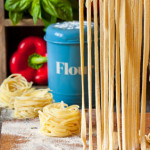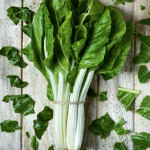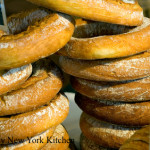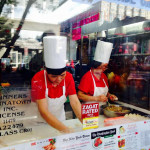Lucky Foods For New Year’s Day
This New Year’s make a resolution to bring yourself a heaping helping of good luck. It’s as easy as just making dinner.
In cultures around the world, the new year is celebrated with particular foods and recipes thought to bring good fortune. Symbolizing wealth, long life, and prosperity, lucky foods are an auspicious and delicious way to celebrate the holiday and welcome good things in the coming year.
Pork & Sauerkraut
Tender braised pork, along with other forms of pork (like sausages and roasts) is a symbol of abundance in Celtic and Chinese cultures, and is popular amongst the Pennsylvania Dutch on New Year’s Day. Paired with the cabbage in sauerkraut, a Chinese symbol of wealth and prosperity, this easy braise with apples and onions is one tasty pot of good luck.
Black Eyed Peas, Greens & Cornbread
Traditionally eaten in the South on New Year’s Day, this trifecta of ingredients represents three different types of money. Leafy greens represent dollar bills, the round peas symbolize coins and cornbread is the color of gold.
Grapes
According to Spanish lore, eating 12 grapes as the clock chimes midnight on New Year’s Eve will bring you 12 months of good luck. Incorporate this tasty tradition by adding grapes to your holiday cheese board or dessert platter. Or try a delicious side dish with savory sautéed Brussels sprouts, grapes, and crunchy walnuts.
Pomegranates
In Greece, smashing a pomegranate on the floor to release the seeds is a surefire way to bring good luck. The seeds represent abundance and fertility. The more seeds you see, the luckier you’ll be. Instead of smashing, sprinkle that good fortune over peak season oranges, mixed greens, and prosciutto for a colorful celebration of a salad.
Fish
Fish are thought to represent progress and abundance because they constantly swim forward and group together in schools. In Czech culture, the scales of the fish are considered lucky because they resemble silver coins and if you carry a silver coin in your wallet it is said that your money will never run out. Celebrate the new year abundantly with a fish dish that everyone will enjoy.
Noodles
No Chinese New Year, Lunar New Year, celebration is complete without a bowl of noodles. Symbolizing longevity and health, noodles are always left whole. Breaking or cutting a long strand of noodles is considered bad luck. Nourish a long life with a longevity noodles dish.
Cake
Ring shaped cakes, like Bundt cakes, are a sweet way to celebrate coming full circle from the previous year. In cultures around the Mediterranean, a coin is baked into the cake and thought to bring wealth and good fortune to the lucky recipient who finds it. Bake a delicious ring-shaped cake and be sure to warn your guests if you decide to bake it with a coin hidden inside.
©Tiny New York Kitchen © 2020 All Rights Reserved
There are a few pasta cooking rules that are important to memorize and you’ll have perfect pasta every time.
Boil your noodles in well-salted water, save that pasta liquid to make the glossiest pan sauce, do not rinse cooked pasta, and always pass extra grated parmesan cheese at the table.
“Work With What You Got!”
©Tiny New York Kitchen © 2019 All Rights Reserved
I like to eat seasonal fruits and vegetables. Brussels sprouts are a hearty winter vegetable and are sweetest and most tender after a hard frost. They are a good source of fiber, antioxidants, and vitamin C. Look for young, small green sprouts that have tightly formed buds. Avoid any yellowing, which means that the sprouts will be bitter, sulfurous, and tough. Use fresh sprouts within a few days after purchasing. Sprouts sold on the stalk tend to keep longer. Brussels sprouts can be boiled, braised, or steamed. Cut an X at the base of each sprout to allow for a more even cooking. Add a bit of butter, olive oil, salt, pepper, garlic, onions, or herbs of your choice. Brussels sprouts also make a nice addition to stir fry, noodles, and other dishes. As always, be creative and “work with what you got!”
“Work With What You Got!”
© Victoria Hart Glavin Tiny New York Kitchen © 2017 All Rights Reserved
Lunar New Year 2016
This year, the Lunar New Year will begin on Monday, February 8. It is the biggest event of the year for Chinese people and Chinese emigrants throughout the world. Although there are various styles of celebrating the Lunar New Year, the spirit behind these celebrations is the same. The beginning of the New Year marks a time for a fresh start, so people try to clean up everything completely and tie up loose ends before the end of the previous year. On New Year’s Day, people wear new clothes. This day people also pay their respects to their ancestors, so it is a family reunion day rather than a day for dining out and partying. Families go to temples to pray for deceased family members and offer them special Near Year foods.
The symbolic color of the Lunar New Year is red. Streets and houses are decorated with red ornaments bearing the characters for happiness, prosperity, peace, and spring, among others. Chinese communities literally turn red. Kids receive money from relatives in red envelopes known as hong bao.
Lunar New Year parades attract many spectators, not only those of Chinese descent, but also people outside the Chinese community. The lion dance (not a dragon dance) is the main performance of the parade. The traditional dance is based on a Chinese myth about people successfully driving away monsters. The dance has evolved as the Chinese diaspora has spread throughout the world. There are two main versions: the northern lion dance and the southern lion dance, and the latter is seen more often in the world because more Chinese immigrants are from the southern regions of China.
Firecrackers also enhance the excitement of the parade. You may think firecrackers for the Lunar New Year are too noisy and perhaps scary, but these are meant to drive away evil spirits, so they should be scary! Many people are willing to endure that noise once a year in hopes of staying away from misfortune the rest of the year.
The Lunar New Year celebration culminates with the Lantern Festival on the fifteenth day of the first month in the lunar calendar, which is the first full moon of that lunisolar year. During the event, countless lanterns are hung, decorating temples and streets at night. There are several legends associated with the festival, but the lanterns are almost always red, the color of good fortune.
Lunar New Year cuisine also differs from place to place, although there are some significant similarities. People in most regions eat something wrapped and stuffed (dumplings, spring rolls, banana leaf–or bamboo skin–wrapped sticky rice), something long (noodles), and money-like fruits (tangerines and oranges). Fillings, toppings, and sizes vary depending on the culture, but all foods symbolize good things like abundance, longevity, and prosperity. Whole fish is also symbolic main dish in most Lunar New Year celebrations.
Japanese people celebrate the first day of the New Year as well, but in a very different way. Called Setsubun, the celebration is accompanied by a special ritual of throwing beans to clean away all the evil of the former year in the lunar calendar and drive away disease-bringing evil spirits from the year to come. Roasted soybeans are thrown either out the door or at a member of the family wearing an oni (demon or ogre) mask. The throwers chant “Oni wa soto! Fuku wa uchi!” (“Get out, demons! Come on I, good luck.”)
Japanese people also customarily eat soybeans – one for each year of one’s life (if you are 25 years old, you eat 25 beans) – to usher in good luck. In some areas, people eat one bean for each year of one’s life, plus one more for good luck for the year to come (if you are 25, you eat 26 beans). Also, there are some regions where people bite into futomaki (big sushi rolls) without cutting them at all. They believe that your wish will come true if you bite into an uncut futomaki known as an echo-maki. The “roll” symbolizes “rolling good luck in,” and to bite the “uncut” roll represents not cutting this good fortune.
“Work With What You Got!”
© Victoria Hart Glavin Tiny New York Kitchen © 2016 All Rights Reserved
Lucky Foods To Ring In The New Year
Many cultures believe that some foods are lucky and prepare them on New Year’s to ensure good fortune throughout the upcoming year.
Bagels & Doughnuts. Round foods, like bagels and doughnuts, are a great way to start the day and also symbolize coming full circle. As the year is coming to an end, it’s a good reminder that the New Year is about to begin.
Noodles. In China and Japan, long noodles represent longevity, BUT only if you don’t cut or break the noodles. You may want to make some soba noodles in a nice broth for a New Year’s lunch.
Lentils. Lentils resemble coins and plump when you cook them, which symbolizes growing wealth. Pork sausage cooked with lentils (Cotechino Con Lenticchie) Is a traditional New Year’s dish in Italy.
Fish. Whole fish (head to tail) is said to give you good luck from the beginning of the year to the very end of the year. Roasting a whole fish not only keeps it moist, but also adds extra flavor.
Pork. Pigs typically root forward while planting their feet in the ground. This signifies moving forward. In Spain it is traditional to prepare pork chops with grapes. It is customary to eat 12 grapes at the stroke of midnight in order to bring prosperity in each of the coming months.
Corn. The color of gold, which indicates a year of riches. You may want to make a cornbread to go with your New Year’s meal.
Collard Greens & Black Eyed Peas. This is a traditional Southern combination. The greens look like paper money and the black-eyed peas resemble coins. This dish is not only delicious, but also healthy.
Bundt Cake. Like bagels and doughnuts, a round Bundt cake is a delicious reminder that every new beginning comes from some other beginning’s end.
Don’t Be Greedy. While it’s tempting to eat as much of these “lucky” foods that are thought to give you the most prosperous year yet, it’s important not get too greedy. Leaving food on your plate after midnight is associated with a fully stocked pantry in the New Year.
Tiny New York Kitchen Wishes You And Your Family A Very Healthy & Happy New Year!
“Work With What You Got!”
© Victoria Hart Glavin Tiny New York Kitchen © 2015 All Rights Reserved
Washington D.C.’s Chinatown Express
I don’t know why, but I’m fascinated with Chinatowns so whenever I’m in a different city I like to check out that city’s Chinatown. Washington D.C.’s Chinatown is rather small, but has character all the same.
Chinatown Express is one of Washington D.C.’s most authentic Chinese restaurants, which has been serving locals and tourists for nearly 25 years. As a family run restaurant they pride themselves on serving delicious hand pulled noodles, individually folded dumplings, and roasted meats. As you can see here in the window employees are hard at work making dumplings and noodles.
Location is in the heart of Chinatown – 746 6th Street NW, Washington D.C. 20001 – (202) 638-0424
“Work With What You Got!”
© Victoria Hart Glavin Tiny New York Kitchen All Rights Reserved












